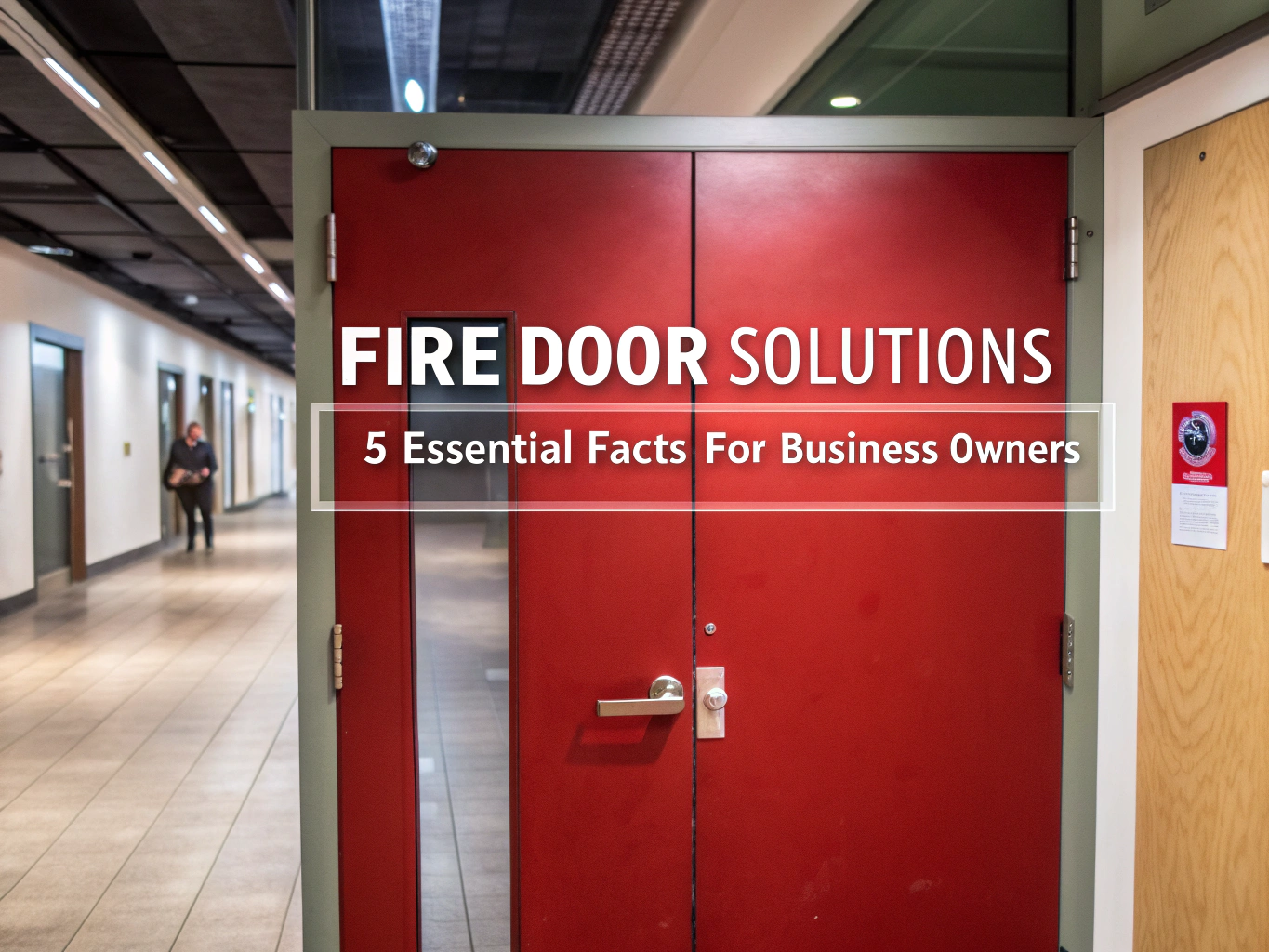
Did you know that a fire door can resist flames for up to 2 hours? These unassuming barriers are key to safeguarding any business property. Understanding what makes them essential is the first step in protecting your enterprise and ensuring everything checks out with safety regulations. Let’s dive into the facts every business owner should know.
Fire doors serve as critical life-saving barriers in commercial buildings, with the market projected to reach USD 23.49 billion by 2032 at a steady growth rate of 6.1%. Business owners face increasing pressure to understand both the technical requirements and legal obligations of fire door systems, as proper implementation directly impacts building occupant safety and property protection during emergencies.
1. Understanding Fire Door Functions and Protection
Fire doors function as a vital component of a building’s passive fire protection system. Unlike active systems such as sprinklers, these specialized doors work by containing flames and smoke to specific areas, creating safe evacuation routes and limiting property damage during fires.
Most commercial fire doors feature ratings that indicate how long they can withstand extreme temperatures—typically ranging from 30 minutes to 2 hours. These ratings (FD30, FD60, FD90, FD120) reflect the door’s ability to maintain structural integrity during fire conditions, giving occupants precious time to evacuate safely.
The effectiveness of fire doors depends on several key components working together:
- Door panels – Made from fire-resistant materials
- Frames – Specially designed to withstand heat expansion
- Hinges – Must maintain integrity under extreme heat
- Intumescent seals – Expand when heated to block smoke passage
- Self-closing mechanisms – Ensure doors remain closed during fires

2. Market Insights and Industry Trends
The fire door market has shown remarkable growth, reaching approximately USD 14.63 billion in 2024. According to Stellar Market Research, this figure is expected to climb to USD 23.49 billion by 2032, representing a compound annual growth rate of 6.1%.
Commercial applications dominate the market, accounting for about 55% of all installations. This prevalence reflects the high demand from business owners seeking to mitigate fire risks and maintain regulatory compliance across various industries.
Regional growth patterns show interesting variations:
| Region | Growth Rate | Key Drivers |
|---|---|---|
| Asia Pacific | 6% (2025-2032) | Rapid urbanization, construction boom |
| North America | 5.2% (2025-2032) | Stringent regulations, renovation projects |
| Europe | 4.8% (2025-2032) | Safety standards, commercial retrofitting |
Leading manufacturers in the industry include established names like Assa Abloy AB, Chase Industries, GEZE GmbH, Hormann, JELD-WEN, and Sanwa Holdings. These companies continue to innovate with advanced fire-resistant materials and smart technologies that enhance safety features while meeting aesthetic demands.
3. Regulatory Requirements and Legal Compliance
NFPA 80 stands as the primary standard governing fire doors in the United States. This comprehensive framework establishes requirements for installation, inspection, testing, and maintenance of fire door assemblies in commercial buildings, as noted by Door Services Corporation.
One of the most critical compliance requirements is the mandate for annual inspections of all fire-rated doors. These inspections must be conducted by qualified individuals and documented properly to demonstrate ongoing compliance.
“Fire door inspections aren’t just about checking boxes—they’re about creating a culture of safety that protects your business, employees, and customers from potentially catastrophic events.”
The consequences of non-compliance can be severe:
- Financial penalties from local authorities
- Denied insurance claims following fire damage
- Legal liability in case of injuries or fatalities
- Business interruption during forced compliance upgrades
- Reputational damage from safety violations
Documentation requirements include maintaining detailed records of all inspections, repairs, and replacements. These records must be readily available for review by fire marshals, building inspectors, and insurance representatives during routine evaluations.
4. Inspection and Maintenance Best Practices
Fire door inspections require specific qualifications to ensure accuracy and compliance. According to Steel Door Institute, inspectors should possess certified training and credentials from recognized organizations such as the Door and Hardware Institute (DHI) or the International Fire Door Inspector (IFDI) program.
A comprehensive inspection checklist should cover these essential elements:
- Verification of certification labels and fire rating
- Examination of door, frame, and hardware for damage
- Testing of self-closing and latching mechanisms
- Measurement of clearances and gaps
- Inspection of intumescent seals and smoke gaskets
- Confirmation that no unauthorized modifications exist
- Verification that nothing impedes door operation
When issues are identified during inspections, specific repair and replacement protocols must be followed. Minor problems can often be addressed through immediate corrective actions, while more significant issues may require complete replacement of the door assembly by certified technicians.
For optimal maintenance, I recommend this scheduling approach:
| Inspection Type | Frequency | Performed By |
|---|---|---|
| Visual check | Monthly | Facility staff |
| Operational test | Quarterly | Maintenance personnel |
| Comprehensive inspection | Annually | Certified inspector |
| Full assessment | After modifications | Certified inspector |
5. Essential Fire Door Products for Business Owners
Fire Door Options
Selecting the right fire doors for your business is crucial for safety compliance. Here are some top-rated fire exit door options:

VIZ-PRO Double Fire Exit Door with Panic Bar
- Panic bar for quick emergency exits
- Robust steel ensures long-lasting use
- Left side-active design for specific needs
- Outward opening for optimal evacuation
- Suitable for high-traffic areas

VIZ-PRO Single Fire Exit Door with Panic Bar
- Efficient panic bar system for fast egress
- Solid and durable construction
- Right side-hinged for specific layout
- Outward swing for streamlined exit
- Ideal for safety in emergency situations

VIZ-PRO Double Fire Exit Door
- Designed for secure fire exits
- Panic bar enhances safety and speed
- Right side-active for precision fit
- Outward opening for evacuation efficiency
- Reliable steel build provides durability
Inspection Tools and Accessories
Proper inspection requires specialized tools to verify compliance with fire safety standards. Consider these essential inspection accessories:

Aegis Multicolor Fire Door Gauge
- Color-coded for easy measurement
- Helps ensure proper door clearance
- Compact design for portability
- Essential tool for fire safety checks
- Durable and built for frequent use

Fire Door Do Not Block Signs
- Self-adhesive for simple application
- Clear print for visibility
- Durable vinyl withstands elements
- Perfect for doors and walls
- Enhances safety by preventing blockage
Security Enhancements
Beyond basic fire protection, many businesses need to enhance security while maintaining fire safety compliance. Alarm systems specifically designed for fire doors can help monitor unauthorized use or propping open of emergency exits.

STI-6402 Door Alarm for Double Doors
- Loud 105 dB alarm for deterrence
- Fits double doors for enhanced protection
- On/off switch for flexibility
- Includes a 9-volt battery
- Multi-function for various settings
For businesses with high-security needs, consider integrating fire door monitoring with your existing security system. This approach provides centralized oversight of all exits while maintaining fire safety compliance.
Conclusion
Implementing proper fire door solutions represents a critical investment in both safety compliance and business protection. The five key areas covered—understanding fire door functions, market insights, regulatory requirements, inspection practices, and essential products—provide a comprehensive framework for action.
Proactive fire door management delivers significant benefits beyond basic compliance, including reduced insurance premiums, enhanced building occupant safety, and protection of valuable business assets. By treating fire doors as an integral part of your overall safety strategy rather than just a regulatory checkbox, you’ll create a safer environment while demonstrating your commitment to responsible business practices.
The long-term advantages of proper implementation include peace of mind, operational continuity during emergencies, and potentially life-saving protection for employees and customers. With the fire door market continuing to grow and evolve, staying informed about the latest products and compliance requirements will remain an essential aspect of business ownership for years to come.
FAQs
What Is A Fire Door And How Does It Work?
A fire door is a door with a fire-resistance rating used as part of a passive fire protection system to reduce the spread of fire and smoke between separate compartments. It works by providing a barrier to fire and slowing down its spread, allowing more time for evacuation and reducing damage to property.
How Do I Know If A Fire Door Is Up To Code?
To know if a fire door is up to code, check for a certification label from a recognized testing agency. It should also have proper installation, the right hardware, and no damages or alterations that could affect its fire-resistance capabilities. Regular inspections by a fire safety professional are recommended.
Can Fire Doors Be Painted Or Modified?
Fire doors can be painted, but it is crucial to use paint that does not compromise the door’s fire-resistance properties. You should avoid any modifications that could violate the door’s integrity, such as changing the core, cutting, or adding holes without proper verification and compliance with fire door regulations.
What Are The Different Types Of Fire Doors?
There are several types of fire doors including timber fire doors, steel fire doors, and glazed fire doors. These doors vary in materials and can be rated differently depending on their fire-resistance performance, such as FD30 or FD60, indicating they can withstand fire for 30 or 60 minutes respectively.
How Long Do Fire Doors Last?
The lifespan of a fire door can vary depending on use, maintenance, and environmental factors. Typically, a well-maintained fire door can last for several years, but it is important to carry out regular inspections and maintenance to ensure it remains in a safe and effective condition.

Abdelbarie Elkhaddar
Glamorwood Ltd.
A door expert and home improvement writer with over 12 years of experience. I help homeowners and contractors choose smart, stylish, and secure doors.






Leave a Reply